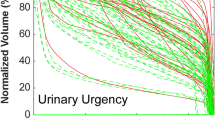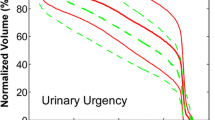Abstract
Objective
To analyze late urinary toxicity after prostate cancer radiotherapy (RT): symptom description and identification of patient characteristics or treatment parameters allowing for the generation of nomograms.
Methods
Nine hundred and sixty-five patients underwent RT in seventeen French centers for localized prostate cancer. Median total dose was 70 Gy (range, 65–80 Gy), using different fractionations (2 or 2.5 Gy/day) and techniques. Late urinary toxicity and the corresponding symptoms (urinary frequency, incontinence, dysuria/decreased stream, and hematuria) were prospectively assessed in half of the patients using the LENT-SOMA classification. Univariate and multivariate Cox regression models addressed patient or treatment-related predictors of late urinary toxicity (≥grade 2). Nomograms were built up, and their performance was assessed.
Results
The median follow-up was 61 months. The 5-year (≥grade 2) global urinary toxicity, urinary frequency, hematuria, dysuria, and urinary incontinence rates were 15, 10, 5, 3 and 1 %, respectively. The 5-year (≥grade 3) urinary toxicity rate was 3 %. The following parameters significantly increased the 5-year risk of global urinary toxicity (≥grade 2): anticoagulant treatment (RR = 2.35), total dose (RR = 1.09), and age (RR = 1.06). Urinary frequency was increased by the total dose (RR = 1.07) and diabetes (RR = 4). Hematuria was increased by anticoagulant treatment (RR = 2.9). Dysuria was increased by the total dose (RR = 1.1). Corresponding nomograms and their calibration plots were generated. Nomogram performance should be validated with external data.
Conclusions
The first nomograms to predict late urinary toxicity but also specific urinary symptoms after prostate RT were generated, contributing to prostate cancer treatment decision.




Similar content being viewed by others
References
D’Amico AV, Whittington R, Malkowicz SB et al (1998) Biochemical outcome after radical prostatectomy, external beam radiation therapy, or interstitial radiation therapy for clinically localized prostate cancer. JAMA 280:969
Cheung R, Tucker SL, Lee AK et al (2005) Dose-response characteristics of low- and intermediate-risk prostate cancer treated with external beam radiotherapy. Int J Radiat Oncol Biol Phys 61:993
Fiorino C, Valdagni R, Rancati T et al (2009) Dose-volume effects for normal tissues in external radiotherapy: pelvis. Radiother Oncol 93:153
Budaus L, Bolla M, Bossi A et al (2012) Functional outcomes and complications following radiation therapy for prostate cancer: a critical analysis of the literature. Eur Urol 61:112
Valdagni R, Kattan MW, Rancati T et al (2012) Is it time to tailor the prediction of radio-induced toxicity in prostate cancer patients? Building the first set of nomograms for late rectal syndrome. Int J Radiat Oncol Biol Phys 82:1957
Valdagni R, Rancati T, Fiorino C (2009) Predictive models of toxicity with external radiotherapy for prostate cancer: clinical issues. Cancer 115:3141
Beckendorf V, Guerif S, Le Prise E et al (2011) 70 Gy versus 80 Gy in localized prostate cancer: 5-year results of GETUG 06 randomized trial. Int J Radiat Oncol Biol Phys 80:1056
de Crevoisier R, Pommier P, Bachaud J et al (2009) Image-guided radiation therapy (IGRT) in prostate cancer: preliminary results in prostate registration and acute toxicity of a randomized study. Int J Radiat Oncol Biol Phys 75:99
Beahrs OH (1992) American Joint Committee on cancer: manual for staging of cancer, 4th edn. JB Lippincott, Philadelphia, PA
Gardner BG, Zietman AL, Shipley WU et al (2002) Late normal tissue sequelae in the second decade after high dose radiation therapy with combined photons and conformal protons for locally advanced prostate cancer. J Urol 167:123
Herold DM, Hanlon AL, Hanks GE (1999) Diabetes mellitus: a predictor for late radiation morbidity. Int J Radiat Oncol Biol Phys 43:475
Takeda K, Ogawa Y, Ariga H et al (2009) Clinical correlations between treatment with anticoagulants/antiaggregants and late rectal toxicity after radiotherapy for prostate cancer. Anticancer Res 29:1831
Choe KS, Jani AB, Liauw SL (2010) External beam radiotherapy for prostate cancer patients on anticoagulation therapy: how significant is the bleeding toxicity? Int J Radiat Oncol Biol Phys 76:755
Novara G, Ficarra V, D’Elia C et al (2010) Evaluating urinary continence and preoperative predictors of urinary continence after robot assisted laparoscopic radical prostatectomy. J Urol 184:1028
Teber D, Sofikerim M, Ates M et al (2010) Is type 2 diabetes mellitus a predictive factor for incontinence after laparoscopic radical prostatectomy? A matched pair and multivariate analysis. J Urol 183:1087
Pollack A, Zagars GK, Starkschall G et al (2002) Prostate cancer radiation dose response: results of the M. D. Anderson phase III randomized trial. Int J Radiat Oncol Biol Phys 53:1097
Zietman AL, DeSilvio ML, Slater JD et al (2005) Comparison of conventional-dose vs high-dose conformal radiation therapy in clinically localized adenocarcinoma of the prostate: a randomized controlled trial. JAMA 294:1233
Dearnaley DP, Sydes MR, Graham JD et al (2007) Escalated-dose versus standard-dose conformal radiotherapy in prostate cancer: first results from the MRC RT01 randomised controlled trial. Lancet Oncol 8:475
Al-Mamgani A, van Putten WL, Heemsbergen WD et al (2008) Update of Dutch multicenter dose-escalation trial of radiotherapy for localized prostate cancer. Int J Radiat Oncol Biol Phys 72:980
Zelefsky MJ, Levin EJ, Hunt M et al (2008) Incidence of late rectal and urinary toxicities after three-dimensional conformal radiotherapy and intensity-modulated radiotherapy for localized prostate cancer. Int J Radiat Oncol Biol Phys 70:1124
Leborgne F, Fowler J (2009) Late outcomes following hypofractionated conformal radiotherapy vs. standard fractionation for localized prostate cancer: a nonrandomized contemporary comparison. Int J Radiat Oncol Biol Phys 74:1441
Namiki S, Ishidoya S, Ito A et al (2009) Five-year follow-up of health-related quality of life after intensity-modulated radiation therapy for prostate cancer. Jpn J Clin Oncol 39:732
Alicikus ZA, Yamada Y, Zhang Z et al (2011) Ten-year outcomes of high-dose, intensity-modulated radiotherapy for localized prostate cancer. Cancer 117:1429
Wallner K, Roy J, Harrison L (1995) Dosimetry guidelines to minimize urethral and rectal morbidity following transperineal I-125 prostate brachytherapy. Int J Radiat Oncol Biol Phys 32:465
Zelefsky MJ, Kollmeier M, Cox B et al (2012) Improved clinical outcomes with high-dose image guided radiotherapy compared with non-IGRT for the treatment of clinically localized prostate cancer. Int J Radiat Oncol Biol Phys (in press)
Acknowledgments
Authors would like to thank Marian LEE for her critical review.
Author information
Authors and Affiliations
Corresponding author
Rights and permissions
About this article
Cite this article
Mathieu, R., Arango, J.D.O., Beckendorf, V. et al. Nomograms to predict late urinary toxicity after prostate cancer radiotherapy. World J Urol 32, 743–751 (2014). https://doi.org/10.1007/s00345-013-1146-8
Received:
Accepted:
Published:
Issue Date:
DOI: https://doi.org/10.1007/s00345-013-1146-8




